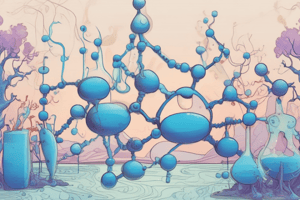Podcast
Questions and Answers
What property of aldehydes is responsible for their polarity?
What property of aldehydes is responsible for their polarity?
- Low nucleophilicity
- High acidity
- Partial positive charge on the carbonyl carbon (correct)
- High lipophilicity
Which of the following is a major synthetic approach for ketone formation?
Which of the following is a major synthetic approach for ketone formation?
- Organocatalysis of esters
- Carbonylation of hydrocarbons (correct)
- Transesterification of alcohols
- Decarboxylation of aldehydes
What characteristic makes ketones valuable as solvents in various industries?
What characteristic makes ketones valuable as solvents in various industries?
- Low cost and absence of impurities (correct)
- High nucleophilicity
- Strong acidity
- High reactivity
In what way does the electrophilic nature of aldehydes manifest?
In what way does the electrophilic nature of aldehydes manifest?
Which method involves the swapping of ester groups to form ketones?
Which method involves the swapping of ester groups to form ketones?
Which method is commonly used to convert primary alcohols into aldehydes?
Which method is commonly used to convert primary alcohols into aldehydes?
What is the function of aldehydes in the realm of organic chemistry?
What is the function of aldehydes in the realm of organic chemistry?
What is the role of dehydrating agents in the preparation of aldehydes?
What is the role of dehydrating agents in the preparation of aldehydes?
What significant applications do aldehydes have in various sectors?
What significant applications do aldehydes have in various sectors?
Which agent is commonly used for the oxidation of primary alcohols to aldehydes?
Which agent is commonly used for the oxidation of primary alcohols to aldehydes?
Flashcards are hidden until you start studying
Study Notes
Preparation Methods for Aldehydes
In the realm of organic chemistry, various strategies exist for generating aldehydes—carbonyl compounds featuring one hydrogen atom attached to the carbon double-bonded to oxygen. These approaches range from oxidation of primary alcohols to dehydration of carboxylic acids.
For instance, oxidizing agents like potassium permanganate (KMnO₄), moistened dichromate (Cr₂(OH)₆²⁺), and Jones reagent (PCC = pyridinium chlorochromate) often convert primary alcohols into aldehydes. Another method involves redeprotonating the resultant aldehyde hydrate or hemiacetal when treating it with concentrated sulfuric acid (H₂SO₄).
Dehydration of carboxylic acids is another effective approach, typically employing dehydrating agents containing Lewis acids like aluminum chloride (AlCl₃) or phosphorus oxychloride (POCl₃); strong bases may also accelerate decarboxylation. Other strategies involve oxidative cleavage of epoxides and vicinal diols employing metals like ruthenium or manganese dioxide under basic conditions.
Uses of Aldehydes
Aldehydes permeate various sectors due to their ability to form Schiff bases, hydrazones, and semicarbazones by condensing with appropriate nucleophiles. Some significant applications include:
- Intermediates: Aldehydes function as starting points for making more complex organic molecules, particularly sugars, perfumes, flavors, natural products, and pharmaceuticals.
- Flavorings and fragrances: Benzaldehyde, vanillin, hexanal, and citronellal contribute to mouthwatering odors and tastes.
- Crosslinking and resins: Aldehydes combine with dienes or phenolic compounds to produce heat-resistant coatings and adhesives.
Properties of Aldehydes
Aldehydes possess several distinctive characteristics that differentiate them from other classes of organic compounds:
- Polarity: Aldehydes demonstrate partial positive charge on the carbonyl carbon resulting from the electronegativity difference between carbon and oxygen atoms, rendering them polar.
- Nucleophilicity: The electrophilic nature of the carbonyl group renders aldehydes susceptible to attack by nucleophiles.
- Acidity: Aldehydes display varying acidities depending on electronic factors; the simplest example being formaldehyde, which behaves as a weak acid.
- Lipophilicity: Aldehydes show varying affinity toward lipophilic environments due to differences in functionality and substitution patterns.
Ketones: Preparation and Applications
Ketones belong to the carbonyl compound category, characterized by a carbonyl group connecting two alkyl or aryl moieties. Several routes lead to ketone formation, with methods following principles similar to those used for aldehyde synthesis.
Some of the major synthetic approaches for preparing ketones include:
- Carbonylation: Reacting organometallic compounds like Grignard reagents with carbon dioxide and alcohols generates ketones via the Dobzinski-Tishchenko reaction.
- Decarboxylation: Decarboxylation of β-keto acids followed by elimination yields ketones.
- Organocatalysis: Employing organocatalysts, like prolines, in the Knoevenagel condensation of aldehydes and active methylene compounds produces ketones.
- Transesterification: Swapping ester groups leads to ketone formation while utilizing Lewis acids as catalysts.
Uses of Ketones
Ketones excel in various industries primarily because of their stability, simplicity, and potential as versatile synthons.
- Intermediates: Like aldehydes, ketones participate in multiple syntheses to generate more complicated and valuable compounds. Examples include steroids, vitamin E, and pharmaceuticals.
- Solvents: Ketones feature prominently as solvents in cosmetics, pharmaceuticals, and chemical synthesis due to their relatively low cost, odorlessness, and absence of trace impurities.
- Flavorings and fragrances: Certain ketones act as essential ingredients contributing pleasant scents in perfumeries and food flavoring industries, showcasing their significance beyond pure chemical models.
Properties of Ketones
Similar to aldehydes, ketones present specific characteristics that define their behavior and utilization:
- Nonpolarity: Due to the symmetric distribution of electrons in the carbonyl group, ketones display lower polarity compared to aldehydes.
- Lack of acidity: Since there exists no α-hydrogen atom, ketones cannot donate protons, leading to lesser acidity relative to aldehydes.
- Moderately Lipophilic: Ketones occupy an intermediate position between polar and nonpolar compounds due to their balanced interaction with polar and nonpolar environments.
Studying That Suits You
Use AI to generate personalized quizzes and flashcards to suit your learning preferences.




